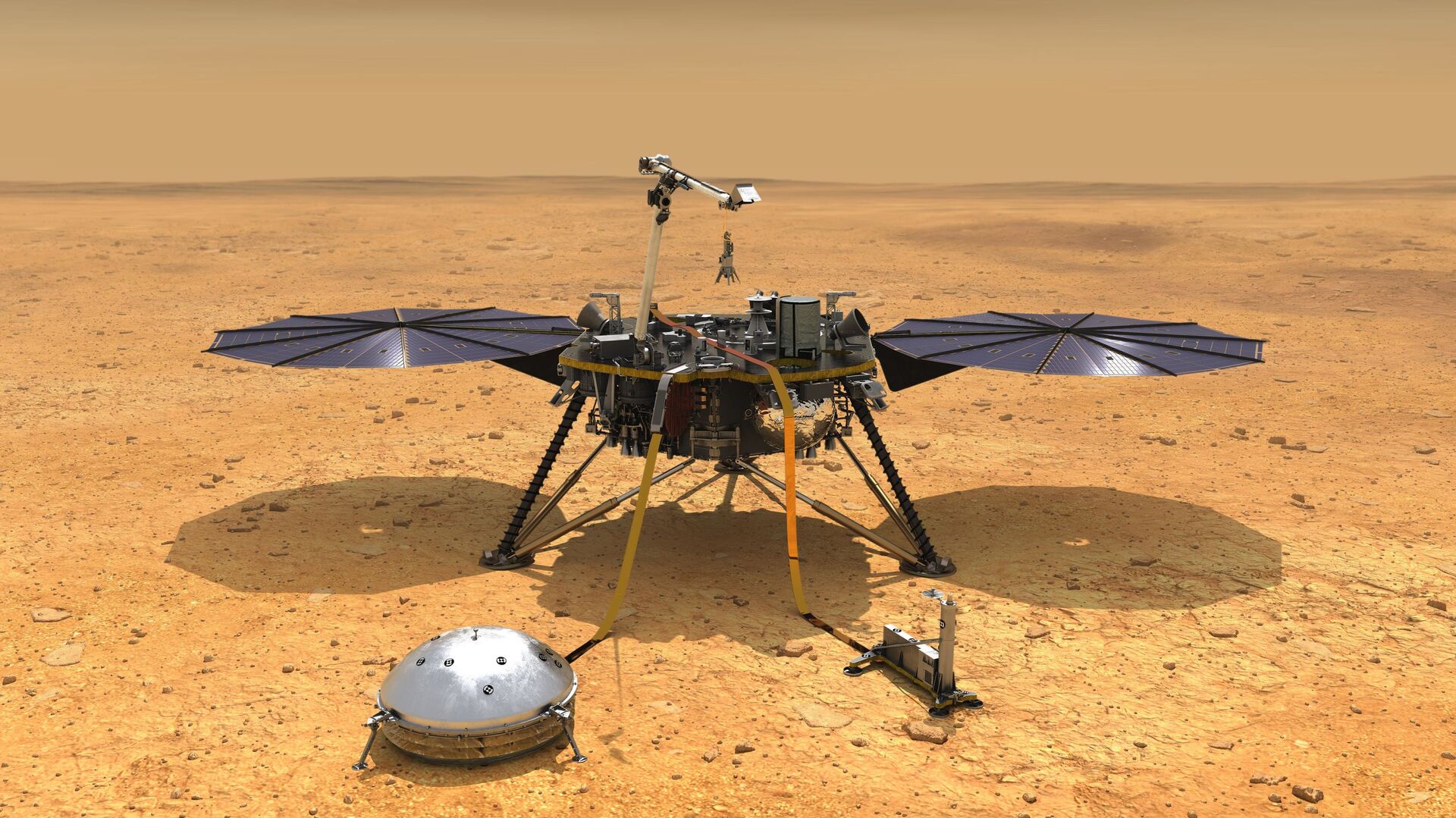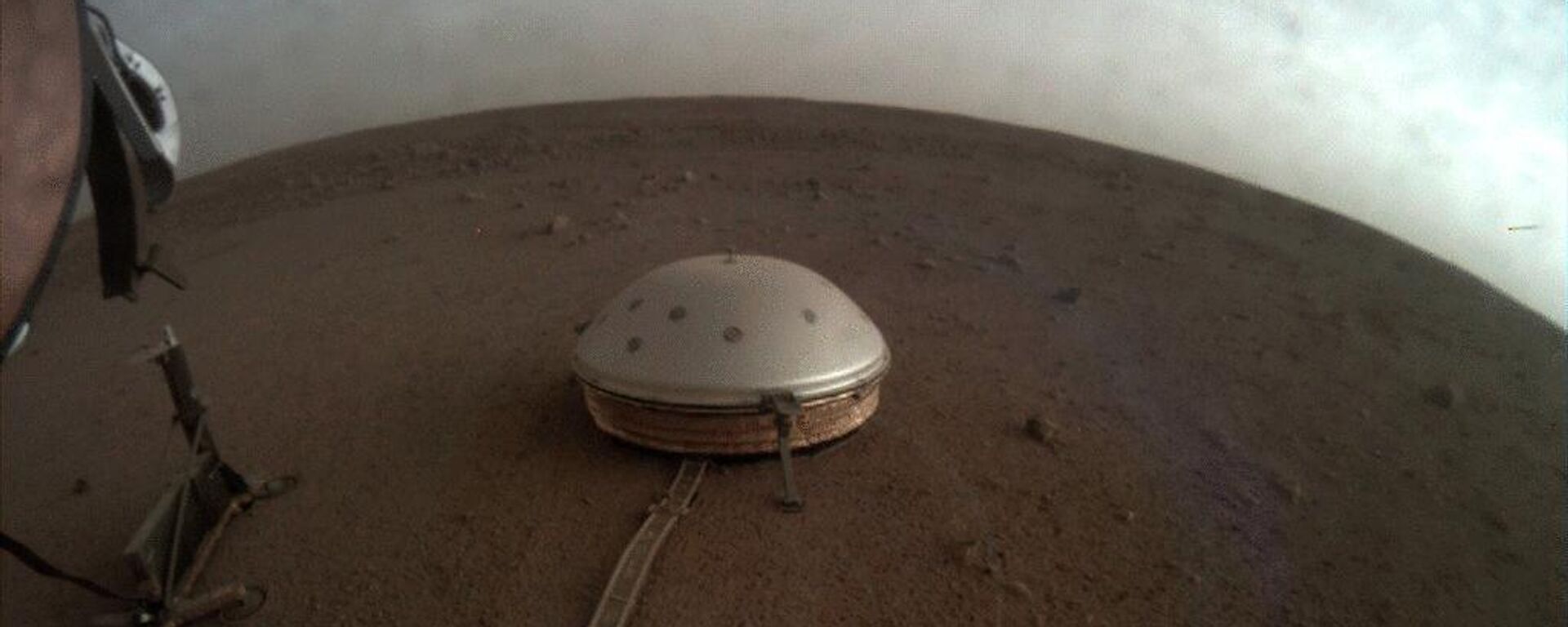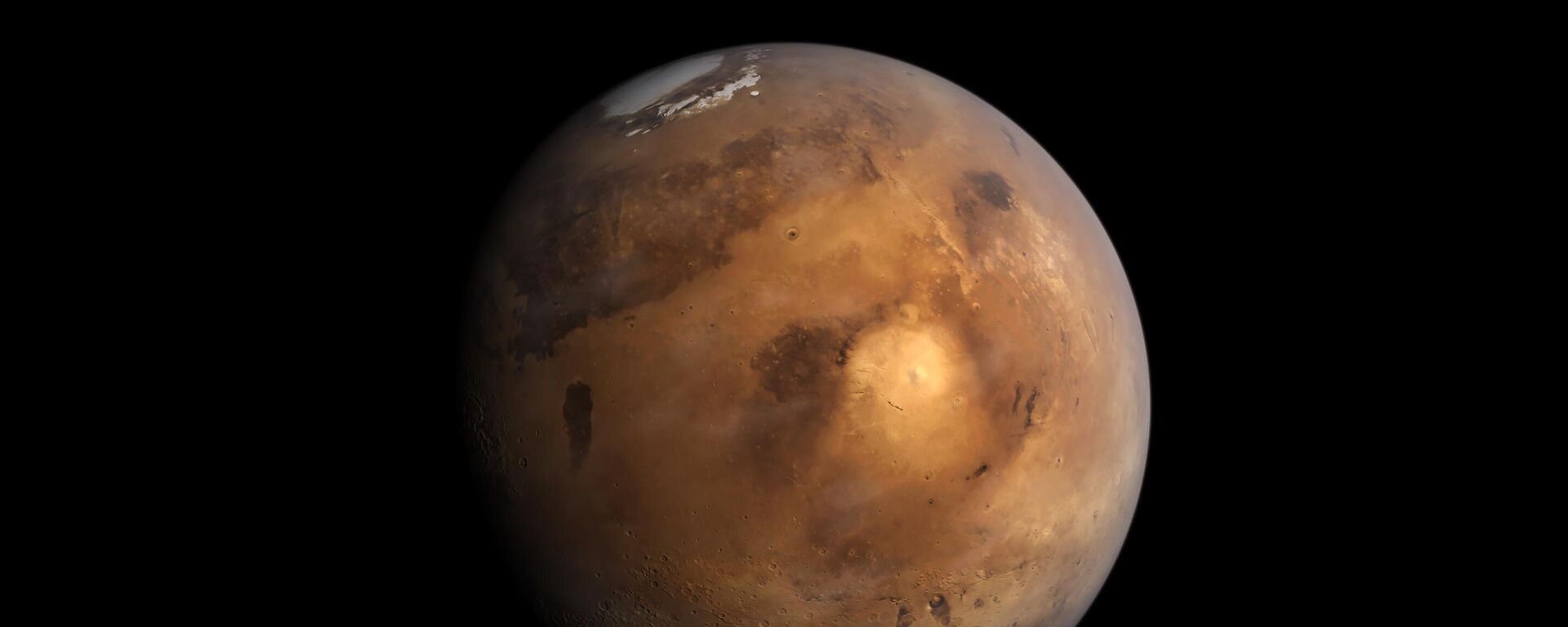https://sputnikglobe.com/20220519/nasas-mars-lander-insight-to-shut-down-due-to-dust---report-1095646459.html
NASA’s Mars Lander InSight to Shut Down Due to Dust - Report
NASA’s Mars Lander InSight to Shut Down Due to Dust - Report
Sputnik International
On November 26, 2018, NASA successfully placed the InSight lander on Martian soil. For the last three and a half years, it has been recording marsquakes and... 19.05.2022, Sputnik International
2022-05-19T23:44+0000
2022-05-19T23:44+0000
2022-11-30T10:10+0000
mars rover
nasa insight mission
insight
earthquake
solar power
technology
science & tech
mars
https://cdn1.img.sputnikglobe.com/img/07e5/04/03/1082531584_13:0:3654:2048_1920x0_80_0_0_494eb59eaa74a565ccf3a96d05b3773e.jpg
The InSight Mars Lander is losing power and will soon shut down due to dust accumulation on its two solar panels.The lander had already completed its primary mission by 2020. It has since been working on an extended mission that it will – unfortunately – have to abandon when it runs out of power, likely in July.NASA will keep the seismometer running as long as it can, detecting marsquakes, as it has since its mission began in 2018. To do this, they will turn most everything off and only turn the seismometer on at night when winds are lowest. This will enable them to keep things running a little longer, but by December, NASA expects the lander to become completely inoperable.InSight was designed to examine the interior of Mars and thanks to its work, NASA now knows the depth and composition of Mars’ crust, mantle, and core. It also informed us of where quakes are most prevalent on the red planet, detecting more than 1,300 marsquakes, including the biggest one ever recorded, a magnitude 5, on May 4.When InSight first landed on Mars, it was creating 5,000 watt-hours a Martin day, roughly 24 hours and 40 minutes, or enough to power an electric oven for one hour and 40 minutes. Now the lander is only creating 500 watt-hours a day, enough to power the same oven for just ten minutes.NASA was hoping that an atmospheric “dust devil” would come and blow some of the dust away, as it did for the two rovers sent to Mars in 2003, but they were out of luck with the InSight.Later this month, NASA will put InSight’s arm into a “retirement pose” and turn off everything besides the seismometer, which will remain operational until the end of the summer. After that, NASA will still be able to communicate with the lander, who will be able to take pictures and not much else. Then, once power runs out, InSight is expected to become inoperable and uncommunicative.If NASA gets lucky, a windstorm may still save InSight. NASA estimates that if just 25% of the solar panels were wiped clean, it could start collecting 1,000 watt-hours per Martin day and turn all of its instruments back on.This is not the first time NASA has had issues with Martin dust. The Opportunity rover that landed in 2004 went offline after a planet-wide dust storm covered its panels in 2018.Removing Martian dust is not as trivial as it may seem. Wipers, like those seen on cars, would likely be ineffective because some of the dust particles are only 1-2 micrometers in size. A brush may work, but it would likely scratch the solar panels which would be even worse than dust accumulation.A blower has been proposed, but that would require a lot of power in Mars’ thin atmosphere and would add a lot of complexity. Shaking was another idea, but that would require heavy equipment and every ounce of matter has to be accounted for in flights to Mars. Washing could also work, but it would require a large supply, and shipping that much liquid to Mars would have added considerable expense.The most promising solution, according to New Scientist, was electrostatic dust removal, but that likewise would require additional mechanical complexity and power.So instead, NASA built InSight in a way that it was fairly confident it could complete its primary mission and then hoped for the best for the extended mission. They nearly got four years of full operation out of InSight, so it’s not all bad.NASA’s Curiosity Rover used an alternative power source, a radioisotope thermoelectric generator, essentially a nuclear battery. That system created 125 watt-hours per Martian day when it landed in 2012, which will slowly lose power capacity as its radioactive material decays. By 2028, its power capacity will reduce to 100 watt-hours per Martian day.
https://sputnikglobe.com/20220510/nasas-rover-records-magnitude-5-quake-on-mars-strongest-ever-in-history-of-planets-study-1095413472.html
https://sputnikglobe.com/20220427/solar-power-can-help-humans-survive-on-mars-scientists-say-1095094891.html
mars
Sputnik International
feedback@sputniknews.com
+74956456601
MIA „Rossiya Segodnya“
2022
News
en_EN
Sputnik International
feedback@sputniknews.com
+74956456601
MIA „Rossiya Segodnya“
Sputnik International
feedback@sputniknews.com
+74956456601
MIA „Rossiya Segodnya“
mars rover, nasa insight mission, insight, earthquake, solar power, technology, science & tech, mars
mars rover, nasa insight mission, insight, earthquake, solar power, technology, science & tech, mars
NASA’s Mars Lander InSight to Shut Down Due to Dust - Report
23:44 GMT 19.05.2022 (Updated: 10:10 GMT 30.11.2022) On November 26, 2018, NASA successfully placed the InSight lander on Martian soil. For the last three and a half years, it has been recording marsquakes and giving us our first clues about Mars’ interior makeup.
The InSight Mars Lander is losing power and will soon shut down due to dust accumulation on its two solar panels.
The lander had already completed its primary mission by 2020. It has since been working on an extended mission that it will – unfortunately – have to abandon when it runs out of power, likely in July.
NASA will keep the seismometer running as long as it can, detecting marsquakes, as it has since its mission began in 2018. To do this, they will turn most everything off and only turn the seismometer on at night when winds are lowest. This will enable them to keep things running a little longer, but by December, NASA expects the lander to become completely inoperable.
InSight was designed to examine the interior of Mars and thanks to its work, NASA now knows the depth and composition of Mars’ crust, mantle, and core. It also informed us of where quakes are most prevalent on the red planet, detecting more than 1,300 marsquakes, including the biggest one ever recorded, a magnitude 5, on May 4.
When InSight first landed on Mars, it was creating 5,000 watt-hours a Martin day, roughly 24 hours and 40 minutes, or enough to power an electric oven for one hour and 40 minutes. Now the lander is only creating 500 watt-hours a day, enough to power the same oven for just ten minutes.
NASA was hoping that an atmospheric “dust devil” would come and blow some of the dust away, as it did for the two rovers sent to Mars in 2003, but they were out of luck with the InSight.
Later this month, NASA will put InSight’s arm into a “retirement pose” and turn off everything besides the seismometer, which will remain operational until the end of the summer. After that, NASA will still be able to communicate with the lander, who will be able to take pictures and not much else. Then, once power runs out, InSight is expected to become inoperable and uncommunicative.
If NASA gets lucky, a windstorm may still save InSight. NASA estimates that if just 25% of the solar panels were wiped clean, it could start collecting 1,000 watt-hours per Martin day and turn all of its instruments back on.
This is not the first time NASA has had issues with Martin dust. The Opportunity rover that landed in 2004 went offline after a planet-wide dust storm covered its panels in 2018.
Removing Martian dust is not as trivial as it may seem. Wipers, like those seen on cars, would likely be ineffective because some of the dust particles are only 1-2 micrometers in size. A brush may work, but it would likely scratch the solar panels which would be even worse than dust accumulation.
A blower has been proposed, but that would require a lot of power in Mars’ thin atmosphere and would add a lot of complexity. Shaking was another idea, but that would require heavy equipment and every ounce of matter has to be accounted for in flights to Mars. Washing could also work, but it would require a large supply, and shipping that much liquid to Mars would have added considerable expense.
The most promising solution, according to
New Scientist, was electrostatic dust removal, but that likewise would require additional mechanical complexity and power.
So instead, NASA built InSight in a way that it was fairly confident it could complete its primary mission and then hoped for the best for the extended mission. They nearly got four years of full operation out of InSight, so it’s not all bad.
NASA’s Curiosity Rover used an alternative power source, a radioisotope thermoelectric generator, essentially a nuclear battery. That system created 125 watt-hours per Martian day when it landed in 2012, which will slowly lose power capacity as its radioactive material decays. By 2028, its power capacity will reduce to 100 watt-hours per Martian day.



